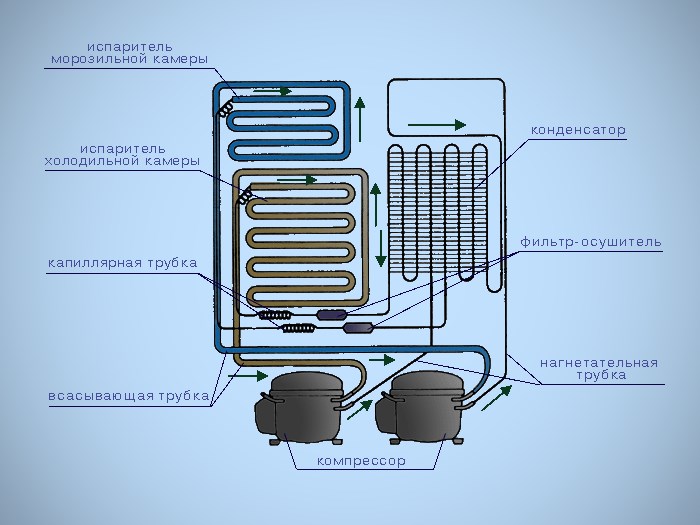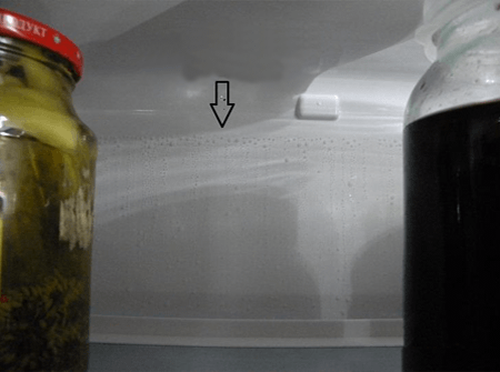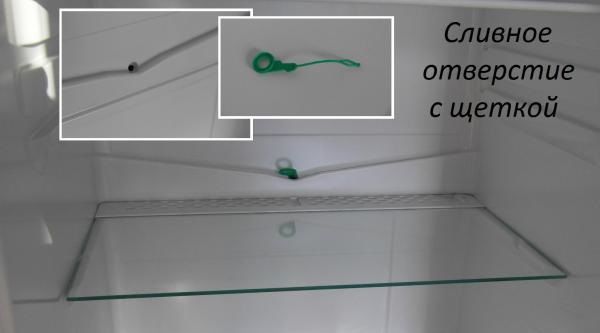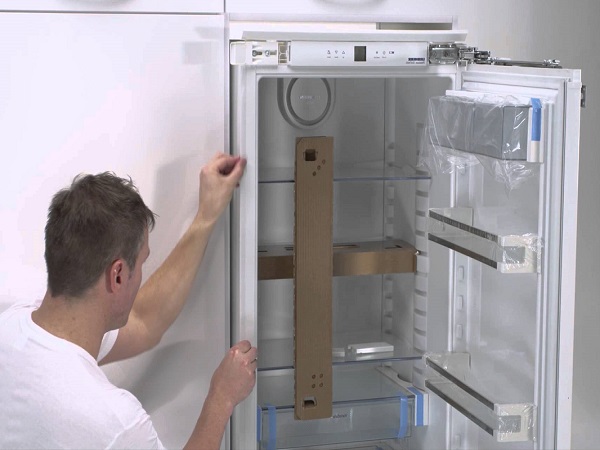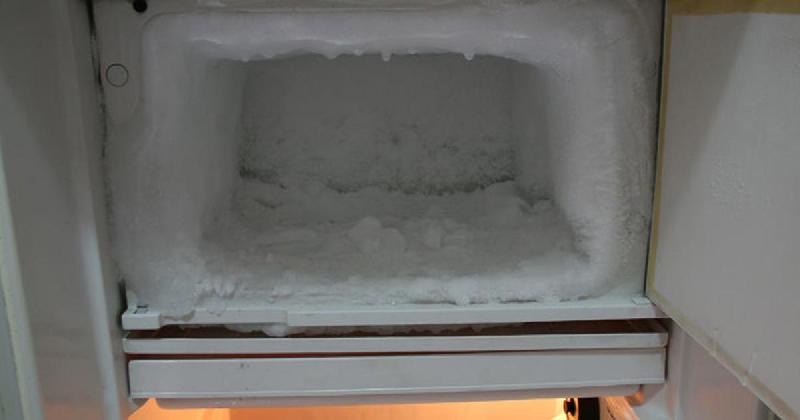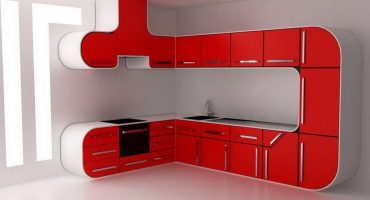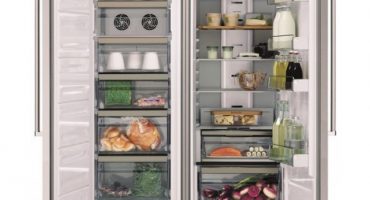If you periodically notice that your refrigerator is crying a lot - condensation is accumulating in the lower part of the chamber (usually under the drawers), or the water left overnight does not freeze in the freezer for some reason, so you need to seriously think about the state of the art. Most often, violations in the operation of the device are eliminated by their own efforts. Let's take a closer look at how to do this.
Type of refrigeration device
To find out the cause of the failure, you should understand the internal structure of the device. Modern refrigeration devices are divided into two types.
With drip thawing system
Such refrigerators are also called "crying", as the rear inner wall of the chamber is constantly covered with droplets of condensate. This is because there is an evaporative element behind it, which, when cooled (caused by compressor operation), is covered with hoarfrost.
The refrigerator wall is also covered with frozen droplets of ice. However, after sufficient cooling of the refrigerator compartment, the evaporator gradually heats up and melt water flows into the drainage compartment at the bottom of the refrigerator compartment. From there, the hose flows into the tray under which the compressor is located. There, moisture should evaporate naturally. If condensation remains, the drain is clogged and needs to be cleaned.
With No Frost Defrost Technology
The difference between such chambers and chambers with a drip defrost is that the former do not have an evaporator in the refrigerator compartment, and the cooling process is completely due to the freezer. The freezer is equipped with a fan, with which cold air enters the refrigerator compartment. Often, the fan becomes the cause of “weathering” of products, so it is recommended to store food in unopened packages. Cooled air is supplied in through a special valve. It closes at the desired temperature and reopens when the temperature inside the chamber rises.
Drip defrost system: how to get rid of excess water in the refrigerator yourself
Moisture accumulation at the bottom of the refrigerator is possible for several reasons:
- drain hole / drain hose clogged;
- the refrigerator is not installed correctly;
- Elementary rules for using the device are not respected.
Let’s take a closer look at how to deal with the problem of accumulation of water in this type of refrigerator.
Violation of the operating rules
Sometimes housewives leave liquid foods in the refrigerator without a lid. Thus, the moisture evaporates, and the rear outer surface of the chamber is abundantly condensed.
Very hot products, which are immediately refrigerated after cooking, provoke an active accumulation of condensate in the refrigerator compartment and lead to poor frost production.
In addition, low temperatures can also cause increased humidity in the refrigerator. Along with a decrease in degrees, air humidity also drops.
Important! Abundant condensation on the walls is temporary. If you follow the rules of use, humidity decreases.
Drain hole or drain hose clogged
A drain hose moves melt water from the drain compartment to a special container above the compressor. Clogging can occur in the sink itself, where dust often gets in with the condensate.
When the drainage compartment is clogged, the melted water does not leave, but flows down under the chamber drawers. Sometimes, when cooled, drops of excess water freeze and the drainage compartment is covered with ice.
It is not worth ignoring such a malfunction, since it can lead to a complete coating of the evaporator with ice and a violation of cold conduction. Because of this, the compressor will work more actively and produce a lot of noise. You can fix the clogging problem by cleaning the drain hole. There are several ways to do this.
Using an ear stick and douche:
- Disconnect the unit from the power supply. Unplug the cord, free the bottom of the refrigerator.
- Clean the drain hole. If you cannot see the ice crust around, clean the hole with a cotton swab. If you purchased a refrigerator with a special cleaning tool, use it.
- Rinse the drain. Insert water into the drain with a syringe. If glass water is in the condensate tray, the cause is eliminated.
If liquid is poured back into the refrigerator, the drain hose may be frozen. In this case, you must completely defrost the refrigerator.
Defrost the refrigerator, use wire if necessary
- Leave the equipment to defrost for several hours, clean the drain with a cotton swab and a douche.
- Using a wire, remove the blockage in the drain hose. If water still does not drain into the tray, clean the channel from the inside with a thin wire. Be careful not to damage the hose and the surfaces of the refrigerator. If the problem persists, call a specialist.
The refrigerator is not installed correctly
If the unit is installed incorrectly, you may notice that the door does not close completely. Because of this, warm air seeps into the refrigerator compartment. The compressor tries to reach the required temperature and works almost constantly.
This load leads to the formation of an ice coating on the surface of the chamber and near the drain, to the absolute freezing of the hole and the channel for the removal of moisture.
During defrosting, the drain hole does not contain melt water, and it collects under the drawers. Thus, the installation of the device should be carried out clearly in terms of level.
Often heated external air penetrates inside not at all due to improper installation, but as a result of depressurization of the device. A gasket is located around the entire perimeter of the door, which ensures tight closure.
Important! The sealant should not have any damage - gaps, waves. If the seal does not fit snugly, small holes form through which the cooled air exits.
When depressurization follows:
- Insert the seal back into the channel if it is displaced. To do this, it is necessary to heat the rubber base (for example, using a hairdryer). After which the material is stretched, and the seal is returned back to the channel.
- If the seal is damaged, replace it with a new one.
Possible breakdowns leading to the appearance of water in cold stores
Problems with the accumulation of water in refrigerators are associated with violations of the freezer. Due to malfunctions in the heater, defrost sensor and timer, the freezer is covered with ice.
The evaporator freezes and can no longer function as before, as a result the compressor is forced to generate more cold. As a result, cold air does not enter the refrigerator compartment well. The ice inside the chamber begins to melt.
If the compressor is constantly running, a large amount of ice has appeared inside the freezer, and the refrigerator compartment does not cool the food, which means that the defrost module has malfunctions in the evaporator heater, timer, fuse or sensor. In this case, a technician call is necessary.
Why does water not freeze in the freezer
Many people prefer the water obtained by freezing filtered water. There are several methods for obtaining “health water”: water from a filter or from a tap, freezing in plastic bottles or in other containers.
However, if after a few hours the water did not freeze in the freezer, it is probably not a device malfunction. It is likely that water contains impurities (e.g. salts). It has been scientifically proven that saline takes much longer to freeze than distilled water.

